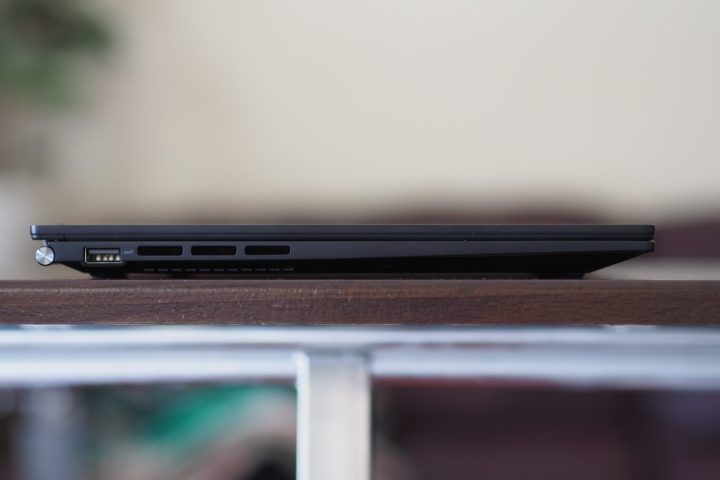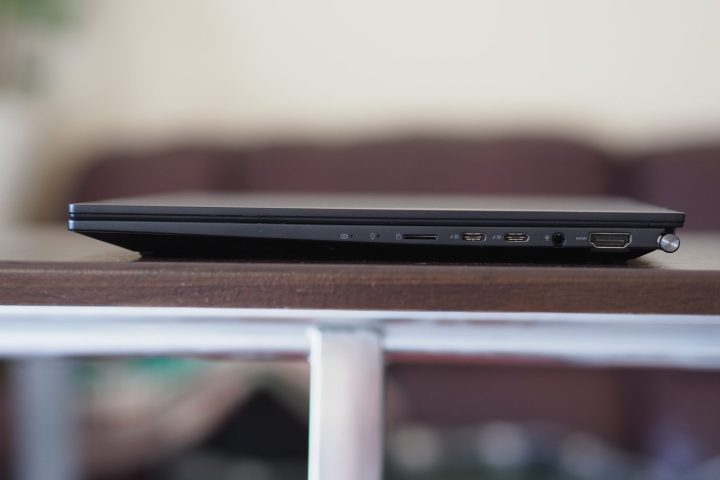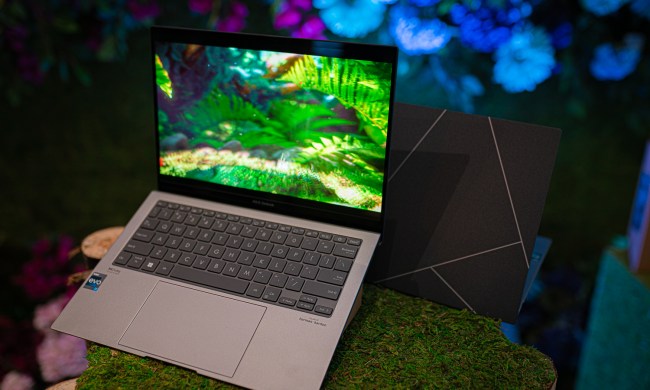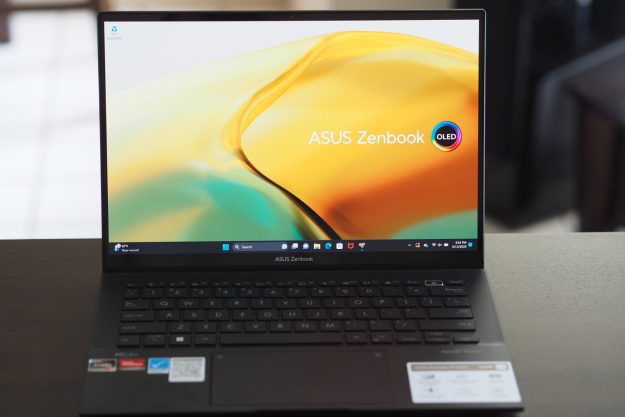
- Excellent value
- Competent productivity performance
- Great battery life
- Comfortable keyboard and NumberPad 2.0 touchpad
- Solid build and attractive aesthetic
- Outstanding OLED display
- Creative performance is lacking
As a reader, I sometimes get pretty far into a laptop review before I see the price. I’m not often surprised, though, because I’ve written enough reviews to have a sense of a laptop’s likely price range. But the newest Asus Zenbook 14 OLED threw me for a loop with its starting price of $700 for a device with a high-res OLED display on board.
That’s a phenomenal price when you get one of the best display technologies going. Yes, the entry-level configuration is relatively low-end, but for just $170 more, you can get higher-end components. That’s still an OLED-equipped machine with a solid build, good looks, and decent productivity performance for well under $1,000. Impressive.
Specs and configurations
| Asus Zenbook 14 OLED | |
| Dimensions | 12.34 inches x 8.68 inches x 0.67 inches |
| Weight | 3.06 pounds |
| Processor | AMD Ryzen 5 7530U AMD Ryzen 7 7730U |
| Graphics | AMD Radeon graphics |
| RAM | 8GB 16GB |
| Display | 14.0-inch 16:10 2.8K (2,880 x 1,800) OLED, 90Hz |
| Storage | 256GB SSD 512GB SSD |
| Touch | Yes |
| Ports | 2 x USB-C 3.2 Gen 2 1 x USB-A 3.2 Gen 2 1 x HDMI 2.0 1 x 3.5mm audio jack 1 x microSD card reader |
| Wireless | Wi-Fi 6E and Bluetooth 5.2 |
| Webcam | 1080p |
| Operating system | Windows 11 |
| Battery | 75 watt-hours |
| Price | $700+ |
Asus sells two versions of the ZenBook 14 OLED. There’s my review unit, which costs $700 for an AMD Ryzen 5 7530U CPU, 8GB of RAM, a 256GB SSD, and a 14.0-inch 2.8K OLED panel running at 90Hz. Or for $870, you get an AMD Ryzen 7 7730U, 16GB of RAM, a 512GB SSD, and the same gorgeous display. I recommend that you go for the latter model, which will provide faster performance and twice the
A better-than-budget design
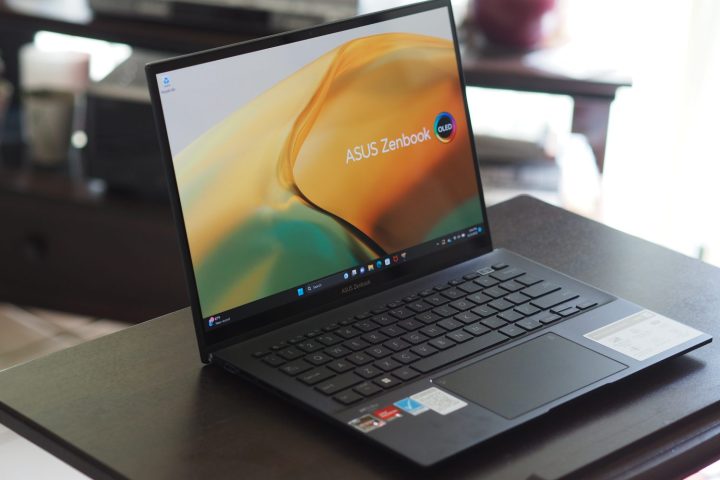
Minimalist designs have come to dominate laptops over the last several years. There’s just not a lot of bling on modern machines, and to my eyes, that’s a good thing. There’s no reason to embellish a laptop with a bunch of unnecessary accents. The Zenbook 14 OLED follows that philosophy with just a few accents to stand out. Its lines are sleek, its logos are subtle, and the only thing that truly sets the aesthetic apart is a rounded hinge that looks great from the side. Asus has pretty much abandoned the once-iconic concentric circles on the lid, and the Zenbook 14 OLED has a solid black chassis that looks great.
It’s also built fairly well, with an all-aluminum alloy chassis that resists flexing on the bottom and the keyboard deck. The display is a little bendable if you exert enough force, which makes it slightly less rigid than, say, the Dell XPS 13 Plus. But it’s also much less expensive, and indeed, it’s a quality build for the price.
The ZenBook 14 OLED’s display bezels aren’t the smallest around, but it still manages to be nicely sized. It’s just 0.67 inches thick and weighs a reasonable 3.06 pounds. It’s not the thinnest or lightest 14-inch laptop, but it remains quite portable.
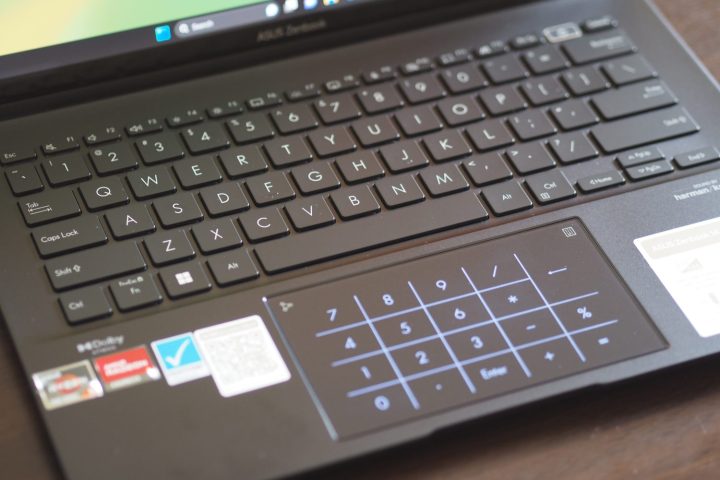
You’ll love the keyboard, which has large keycaps and great key spacing. The switches are light and snappy, with maybe just a tiny bit of feedback separating them from the best Windows keyboards on Dell’s XPS line and HP’s Spectre machines. It also can’t match the absolute best, Apple’s Magic Keyboard on its latest MacBooks, but it’s not going to slow you down. The touchpad is large and has confident button clicks that are just a little loud. Asus incorporated its NumberPad 2.0 technology into the touchpad, which reveals an LED numeric keypad with the touch of a button. If you enter a lot of numbers, then you’ll appreciate it, and if you don’t, then it doesn’t get in the way. But it’s another nice feature to have at such an attractive price.
There are a lot of ports, with a mix of USB-C and more legacy connections like USB-A and HDMI. The microSD card reader is welcome, although a full-size reader is always preferable. And its wireless connectivity is up to date. Its one weakness is the lack of Thunderbolt 4, but that’s a limitation of the AMD chipset.
The webcam is 1080p and provides a quality image. The Zenbook 14 OLED doesn’t have an infrared camera for Windows 11 Hello via facial recognition, but the fingerprint reader built into the power button works well.
Low-power CPU limited to productivity work

My review unit featured one of AMD’s low-power CPUs, the 6-core/12-thread Ryzen 5 7530U running at 15 watts and up to 4.5GHz. It’s the first laptop we’ve tested with this processor, and it compares well against the Intel Core i7-1355U, a 15-watt chip with 10 cores (two Performance at 5GHz and eight Efficient at 3.7GHz) and 12 threads. As usual, Intel’s single-core performance was better, while AMD’s multi-core prowess took the lead. The Zenbook also performed well against the Apple MacBook Air M2 in CPU-intensive benchmarks, although the MacBook was faster in creative benchmarks where the GPU is involved.
The Zenbook 14 OLED isn’t the speediest laptop around, but it will handle demanding productivity tasks. Its Radeon graphics scored particularly poorly in the 3DMark Time Spy test at just 1,221 (1,226 in performance mode), so it’s certainly not a gaming machine.
| Geekbench 5 (single / multi) |
Handbrake (seconds) |
Cinebench R23 (single / multi) |
PCMark 10 Complete |
|
| Asus Zenbook 14 OLED (Ryzen 5 7530U) |
Bal: 1,457 / 7,527 Perf: 1,458 / 8,207 |
Bal: 123 Perf: 121 |
Bal: 1,457 / 7,527 Perf: 1,458 / 8,207 |
5,817 |
| HP Dragonfly Pro (Ryzen 7 7736U) |
Bal: 1,530 / 11,158 Perf: N/A |
Bal: 84 Perf: N/A |
Bal: 1,530 / 11,158 Perf: N/A |
6,059 |
| Lenovo Yoga Book 9i (Core i7-1355U) |
Bal: 1,797 / 6,926 Perf: 1,804 / 7,815 |
Bal: 181 Perf: 118 |
Bal: 1,681 / 6,303 Perf: 1,758 / 7,576 |
5,514 |
| Asus Zenbook S 13 OLED 2023 (Core i7-1355U) |
Bal: 1,829 / 6,893 Perf: 1,836 / 6,908 |
Bal: 157 Perf: 135 |
Bal: 1,629 / 6,005 Perf: 1,827 / 6,962 |
5,423 |
| Lenovo Yoga 9i Gen 8 (Core i7-1360P) |
Bal: 1,843 / 8,814 Perf: 1,835 / 10,008 |
Bal: 122 Perf: 101 |
Bal: 1,846 / 8,779 Perf: 1,906 / 9,849 |
6,102 |
| Apple MacBook Air M2 (M2) |
Bal: 1,925 / 8,973 Perf: N/A |
Bal: 151 Perf: N/A |
Bal: 1,600 / 7,938 Perf: N/A |
N/A |
Choosing a low-power CPU wouldn’t be a very smart choice if it didn’t offer great battery life. Fortunately, the Zenbook 14 OLED does just that. The large 75 watt-hour battery doesn’t hurt, I’m sure.
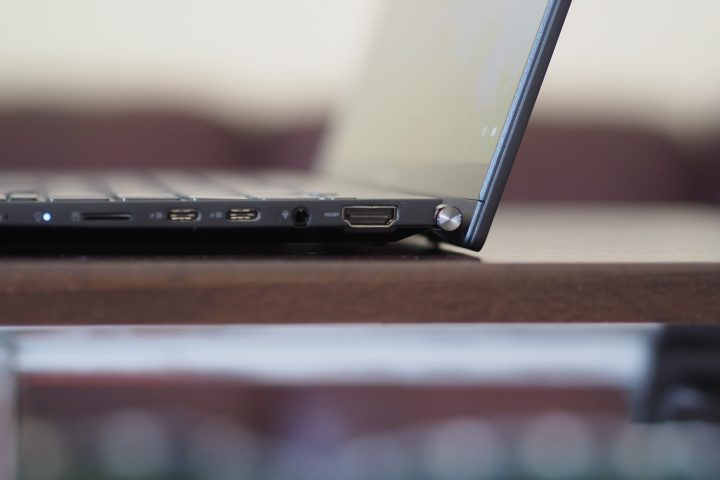
In our battery tests, the Zenbook did quite well against its low-power Intel alternatives. It couldn’t keep up with the class-leading longevity of the Apple Macbook Air M2, but it came closer than most. The much more expensive HP Dragonfly Pro with a low-power AMD Ryzen 7 CPU and IPS display also lasted longer in two of our tests.
The Zenbook 14 OLED is likely to last a full day of work as long as you don’t push things too hard.
| Web browsing | Video | PCMark 10 Applications | |
| Asus Zenbook 14 OLED (Ryzen 5 7530U) |
12 hours, 13 minutes | 17 hours, 19 minutes | 14 hours, 23 minutes |
| Lenovo Yoga Book 9i (Core i7-1355U) |
8 hours, 53 minutes | 9 hours, 53 minutes | 11 hours, 20 minutes |
| Asus Zenbook S 13 OLED 2023 (Core i7-1355U) |
9 hours, 47 minutes | 15 hours, 14 minutes | 12 hours, 50 minutes |
| Lenovo Yoga 9i Gen 8 (Core i7-1360P) |
7 hours, 41 minutes | 13 hours, 25 minutes | 9 hours, 40 minutes |
| HP Dragonfly Pro (Ryzen 7 7736U) |
14 hours, 40 minutes | 15 hours, 57 minutes | 16 hours, 31 minutes |
| Apple MacBook Air M2 (Apple M2) |
17 hours, 59 minutes | 21 hours, 9 minutes | N/A |
An excellent, if not class-leading, OLED display
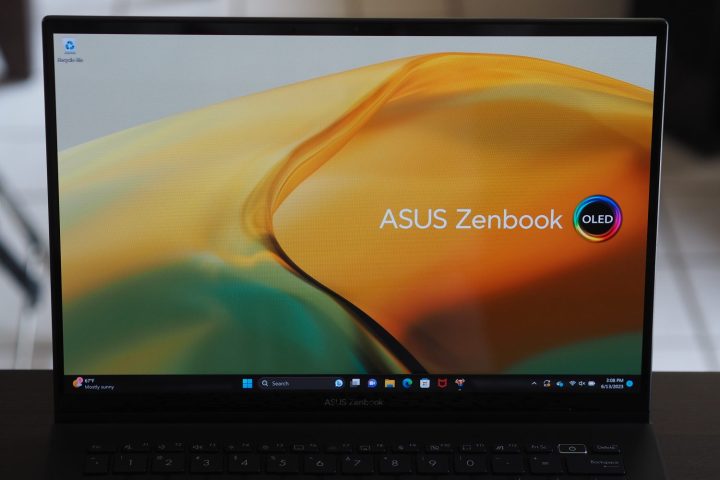
The Zenbook 14 OLED’s display looks excellent out of the box, with bright colors that aren’t oversaturated and the usual OLED inky blacks. That’s true of all OLED displays we’ve tested.
According to my colorimeter, the panel is very good, but it’s not the best OLED display we’ve tested. It’s bright enough at 369 nits, but the OLED display on the Acer Swift Go 14, for example, hit 523 nits. Colors were wide at 100% of sRGB, 96% of AdobeRGB, and 100% of DCI-P3, but accuracy was just good at a DeltaE of 1.44. Many OLED displays are under 1.0 (which is where the human eye can’t tell the difference). Finally, its contrast came in at 25,660:1, which is around average for an OLED display and thus vastly superior to IPS displays.
The isn’t just a great display for the money, it’s a great display, period. It will please productivity users, creators, and media consumers alike, the latter thanks to its VESA DisplayHDR 500-True Black high dynamic range (HDR) support. HDR content looks great, although not as great as the extremely bright mini-LED displays on Apple’s MacBook Pro machines.
There’s not much better for less than $1,000
If you’re looking to spend less than $1,000 on a laptop and aren’t looking for a bargain-basement machine, then I’m not sure you’ll find a better laptop than the Zenbook 14 OLED. It’s fast enough for most users, has excellent battery life, is well-built with a great keyboard and touchpad, and its OLED display is excellent.
In fact, you can spend hundreds more on a laptop and not get a better machine. The Zenbook 14 OLD is a true bargain, and it should be on everyone’s shortlist unless you need a lot more power.

